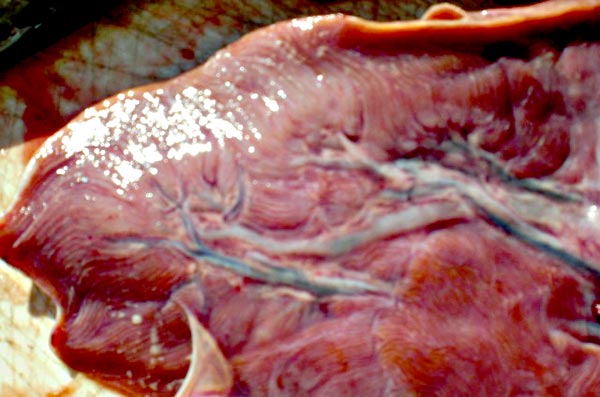Bigeye Tuna
BIGEYE VS. YELLOWFIN TUNA BY DAVID ITANO.PDF
Nice Tuna...but what is it? Identifying the Bigeye Tuna.
By Steve Ross, owner and operator of the boat, Bad Dog, Ensenada, B.C., Mexico.
One of the most difficult fish identification jobs is distinguishing between a Bigeye Tuna (Thunnus obesus) and a Yellowfin Tuna (Thunnus albacares).
There are two methods of examining these fish, exterior and interior. Only the interior examination is 100 percent foolproof. The smaller the size of the tuna, the less effective the exterior examination becomes. The easiest method is to look for first for the characteristics of the Bigeye Tuna first, and by the process of elimination, wind up by concluding you are holding a Yellowfin Tuna.
Exterior Characteristics of a Bigeye Tuna (Thunnus obesus):
1. The Bigeye Tuna's pectoral fins may reach to the second dorsal fin, but are shorter than the Yellowfin Tuna's. A very short pectoral fin indicates that the fish more than likely is a Bluefin Tuna. A very long pectoral fin that reaches beyond the anal fin belongs to an Albacore.
2. There are 18 to 22 gill rakers on the first gill arch of a Bigeye Tuna. There will be 24 to 28 gill rakers on a Bluefin Tuna, and 27 to 33 gill rakers on a Yellowfin Tuna.
3. On a Bigeye Tuna, two dorsal fins are closer together and shorter than on a Yellowfin Tuna. The forward dorsal fin of a Bigeye Tuna has 13 to 14 spines and the rear dorsal fin has 14 to 16 rays.
4. The Bigeye Tuna has a strong lateral keel, between two small keels, located slightly farther back on the tail, on either side of the caudal peduncle.
5. Except for the anterior corselet, the scales of a Bigeye Tuna are small.
6. The Bigeye Tuna's rear dorsal fin is dark brown and edged in black, lacking any yellow.
7. The finlets of the Bigeye Tuna are bright yellow with narrow black edges.
8. Upon expiring, the body of a Bigeye Tuna loses most of its coloration, including the disappearance of its yellow coloration. The dorsal and anal finlets' yellow coloration turns brown after death.
9. The Bigeye Tuna's anal fin is wider and shorter than the Yellowfin Tuna's, and it is colored all silver, with a fringe of yellow and 11 to 15 rays. In a yellowfin tuna the anal fin is long and narrow and only silver in the middle.
10. The corselet (the front area of enlarged scales) of a Bigeye Tuna extends further back than on a Yellowfin Tuna. These front scales are larger up front on both tunas and become smaller along the flanks, which make these tuna appear darker up front. These larger scales cover the fish from the first dorsal fin down around the pectoral fins, and to the ventral fins and then takes a sharp angle backwards. This front area of scales extends further back on a Bigeye Tuna than on a Yellowfin Tuna, all the way to the end of the second dorsal fin. The pectoral fin of a Bigeye Tuna will not cover this extension of scales, while on a Yellowfin Tuna these scales extend barely as far as the second dorsal fin and the pectoral fin will completely cover these scales.
11. The tail of a Bigeye Tuna does not have a white trailing edge. An Albacore's tail has a white trailing edge.
12. The white spots prevalent in small Bigeye Tuna elongate as the fish becomes older.
Interior Characteristics of a Bigeye Tuna (Thunnus obesus):
1. Without a doubt, positive identification of a Bigeye Tuna can be completed by examining its liver. The Bigeye Tuna has a grooved liver with clearly visible striations (fine lines looking like streaks), or dark blood vessels on the margins of the lobes. There are two lobes that are both of the same size. However in the yellowfin tuna these smooth lobes are devoid of these striations and the right lobe is clearly longer than the left lobe or the middle lobe.


Bigeye Tuna caught during fishing by the boat Bad Dog off Ensenada, Baja California, Mexico, as confirmed by examination of the striations present on its liver. Photos courtesy of Steve Ross.
Mexico Fishing Home Page < Fish Photo List < Bigeye Tuna
Copyright ©



